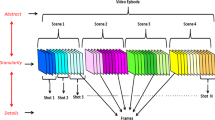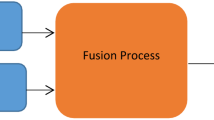Abstract
Flash movie retrieval system can improve the utilization of Flash movie on the Internet. The key step of a content-based Flash movie retrieval system is visual scene segmentation that directly affects the retrieval effect. In this paper, an adaptive threshold method for visual scene segmentation based on frame difference of color histogram is proposed. Firstly, all key frame sequences of a Flash movie are obtained; then the region-weighted color histogram difference of adjacent key frames is calculated; lastly, the visual scene is classified by comparing the result with the average difference. In the process of visual scene segmentation, the spatial characteristics of color are considered and the regional weighting coefficient of key frames is determined by comparing the experiments. The proposed algorithm replaces the traditional fixed global threshold with a variable adaptive threshold. The experiments show that the proposed algorithm has a better detection effect than the fixed threshold algorithm. This algorithm can easily be implemented with moderate computational complexity. The proposed algorithm can be used to extract visual features of the visual scene, generate dynamic summary, and finally can be applied to content-based Flash animation retrieval system. Moreover, the proposed algorithm can also be used in non-flash applications.







Similar content being viewed by others
References
Bulanona DM, Kataokab T, Otac Y, Hiroma T (2002) AE—automation and emerging technologies: a segmentation algorithm for the automatic recognition of Fuji apples at harvest. Biosyst Eng 4(83):405–412
Fei L (2010) Research on Scene Structure and Visual Characteristics of Flash Animation. Shandong Normal University, Shandong, pp 28–29
Haisheng D (2018) Research on TV Advertising Unit Segmentation Based on Video Features. Television technology 42(12):75–78
Hongyu C, Dengxiang D, Jia Y, Cien F (2019) Image Retrieval Based on Significance Semantic Region Weighting. J Comput Appl 39(1):136–142
Juan C, Tanfeng S, Xinghao J (2011) Video shot segmentation algorithm based on dual detection model. J Shanghai Jiaotong University 45(10):1542–1546
Lin S, Xiangzeng M (2017) Extraction algorithm on representative frame images of the Flash animation visual scene. Int J Signal Process, Image Process Pattern Recogn 10(7):85–92
Ling H, Mengsha L, Lijuan W, Xilin Z (2019) Neurological mechanism of visual selective attention. Acta Physiologica Sinica 71(1):11–21
Liu L (2008) Content analysis and feature extraction of Flash movies .Shandong: Shandong Normal University, 52–54
M S A, B T M (1998) Fully automatic segmentation of the brain in MRI. [J]. IEEE Trans Med Imaging 17(1):98–107
Mingmin Z, Sanyang L (2019) A Covariance Matrix Sensitivity Analysis Method for Gauss Networks Based on Improved Bhattacharyya Distance. J Zhejiang Univ 46(1):9–14
Nagasaka A, Tanaka Y (2010) Automatic video indexing and full-motion search for object appearances. Visual Database Systems, Elsevier Science Publication
Nie L, Wang M, Zha ZJ, Li G, Chua TS (2011) Multimedia answering: enriching text QA with media information. Proceeding of the 34th International ACM SIGIR Conference on Research and Development in Information Retrieval, SIGIR 2011, Beijing, China, July 25–29, 2011. ACM
Nie L, Yan S, Wang M, Hong R, Chua TS (2012) Harvesting visual concepts for image search with complex queries. Acm International Conference on Multimedia. ACM
Qiangjun L, Qinan L (2019) Shot Segmentation Method Based on Mutual Information and Autoregressive Model. Comput Technol Dev 29(1):35–39
Shanwu K, Cong J, Xuan Z (2017) Image Retrieval by Fusing Two-Dimensional Shape Features of Significant Region of Image. J Guangxi Univ(Nat Sci Ed) 42(2):728–735
Shi L, Zhenguo X, Meng X (2018) Extraction Algorithms for Dynamic visual effect in Flash animation. Mechatronic Syst Control 46(1):39–45
Ye Z, Yuanyuan D, Li Z (2018) Multi-feature image retrieval algorithm based on block weighting. J Guangxi Univ (Nat Sci Ed) 43(6):2258–2265
Yin Y, Hou H (2010) Adaptive shot segmentation algorithm based on histogram difference. Comput Eng Appl 46(9):186–189
Funding
The work is supported by National Natural Science Foundation of China (61502259), and cooperative project “Tomato Department Store--Implementation Design of Campus New Retail E-commerce Mode in College”.
Author information
Authors and Affiliations
Corresponding author
Ethics declarations
Conflict of interest
The author(s) declare(s) that there is no conflict of interest regarding the publication of this article.
Additional information
Publisher’s note
Springer Nature remains neutral with regard to jurisdictional claims in published maps and institutional affiliations.
Rights and permissions
About this article
Cite this article
Shi, L., Chi, Z. & Meng, X. A New Automatic Visual Scene Segmentation Algorithm for Flash Movie. Multimed Tools Appl 78, 31617–31632 (2019). https://doi.org/10.1007/s11042-019-08024-y
Received:
Revised:
Accepted:
Published:
Issue Date:
DOI: https://doi.org/10.1007/s11042-019-08024-y




